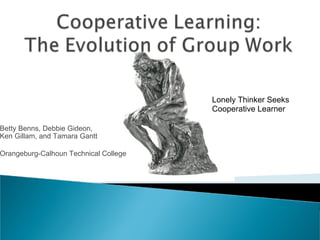
Cooperative learning presentation
- 1. Betty Benns, Debbie Gideon, Ken Gillam, and Tamara Gantt Orangeburg-Calhoun Technical College Lonely Thinker Seeks Cooperative Learner
- 17. Expected Criterion for Success: Both members correctly explain the meaning of the text. Task: To learn the material by integrating the meaning of the paragraphs and formulate a joint summary. Cooperative Goal: Both members to agree on the meaning of the material, formulate a joint summary, and be able to explain its meaning.
- 18. Procedure a. Read headings to get an overview. b. Read the material. b. Summarize the material. c. Check summaries for accuracy.
- 19. Task: To learn all assigned material. Cooperative Goal: To ensure that everyone in the group learns all the assigned material.
- 20. Procedure: 1. Assign students to cooperative groups. 2. Divide the material within each group of material to be covered (Part 1, Part 2, Part 3).
- 21. 3. Students practice teaching their part to ensure their understanding of the material. 4. Students return to cooperative groups to teach and learn 5. Evaluation – Test/concluding activities
Hinweis der Redaktion
- 15 minutes
- The best way to explain cooperative learning is to contrast it with traditional teaching methods that we’ll call the old paradigm (structure or perspective of the world that determines how you understand and interpret the world - Kuhn). The book upon which this presentation is based upon Active Learning , by Johnson and Smith, and describes the old paradigm as a rigid view of the teaching with information flowing only one way, from instructor to student. This is best illustrated by John Locke’s idea of tabula rasa. John Locke, of course, a British philosopher, described the way we come to know the world. Human beings can be viewed as blank tablets (or slates) and experience as that which writes upon the blank tablets, us, human beings. The traditional approach of teaching sees students as ‘blank tablets or paper’ and the instructors are the ones that write upon the blank tablets, our students’ minds. This view limits students to being only these passive, empty containers to be filled with knowledge by an outside source, the instructor. Instructors give, students receive. The student need only memorize what is given or what is written upon them as blank sheets of paper.
- Knowledge is not simply given. The emphasis is on the student. It is the instructor’s responsibility to create conditions that allow the student to formulate their own structures of understanding.
- When students depend upon grades or pizza parties or whatever as their primary motivation for learning, the reward is distanced from the actual material they’re trying to learn. Instead of using extrinsic rewards, cooperative learning taps into the natural inclination that humans have to communicate. As Aristotle said “Man is by nature a social animal” So, cooperative learning uses human nature. For me, I see this like the feeling of happiness when I receive a text message or someone emails me. There is a pleasure in inter-student communication that can be, hopefully, rediscovered in the classroom and used to further educational goals.
- Under the new paradigm, fellow students are more likely to be viewed in a trusting open way. Under the old paradigm, if you’re competing with someone, you’re not likely not share information with them. You might even mislead them.
- While students work you move from group to group making sure they are following the procedures correctly. If everyone in a group makes 90 or above you may wish to give them 5 bonus points. This enhances their motivation to learn the material and help their group members learn as well.
- 15 minutes
- 15 minutes
- We are out of time at this point… so we probably should limit times to 10-12 min each.
